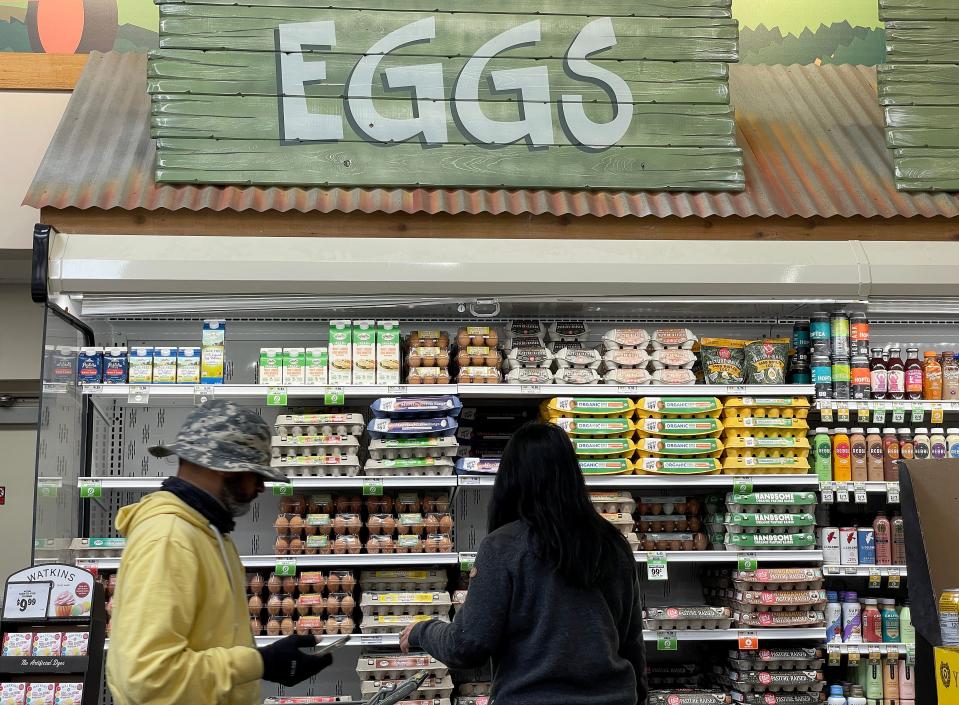PCE inflation measure watched by Fed falls to lowest level in more than 2 years
An inflation measure tracked closely by the Federal Reserve eased sharply in June, a development that could help convince the Fed to hold interest rates steady after a spate of aggressive hikes.
An underlying gauge of price gains that has stayed stubbornly high also slowed substantially.
At the same time, household income and spending both rose smartly, portraying a consumer who still has the wherewithal to splurge and could continue to put upward pressure on prices.
Consumer prices overall increased 3% from a year earlier, below the 3.8% pace in May and the 40-year high of 7% in June 2022, the Commerce Department said Friday. That’s the smallest annual gain since March 2021, though it still tops the Fed’s 2% target.
On a monthly basis, prices ticked up 0.2% following a 0.1% increase the prior month, according to the personal consumption expenditures price index. Prices for used cars and other goods fell by 0.2% while prices for services such as dining out increased by 0.4%.

What is core personal consumption expenditures inflation?
A measure of prices that strips out volatile food and energy items also climbed 0.2%, down from 0.3% the previous month. That nudged down the annual increase in so-called core prices from 4.6% to 4.1%, the lowest since September 2021.
Household spending, meanwhile, jumped 0.5% after edging up 0.2% in May. And incomes grew 0.3%, though that's less than the 0.5% jump the previous month.
That means incomes are outpacing inflation, extending a recent trend and giving Americans more purchasing power. That’s mostly good news, especially for low- and middle-income households whose pay wasn’t keeping pace with surging inflation the past couple of years.
What is the employment cost index?
Separately, U.S. workers’ wages and benefits increased by 1% in the second quarter, slower than the 1.2% gain recorded early in the year and the smallest rise in two years, the Labor Department said. The bump lowered the annual increase in pay and benefits to 4.6% from 4.8% late last year.
Private-sector pay climbed 1% and 4.6% annually, below the 5.1% rise the previous quarter.
"For the Fed, a slowing in wages will be welcome news but gains are still running well above levels consistent with 2% inflation," Rubeela Farooqi, chief U.S. economist of High Frequency Economics wrote in a note to clients.
"But the numbers are heading in the right direction," says Ian Shepherdson, chief economist of Pantheon Macroeconomics.
Together, the two reports are encouraging but could keep the Fed wary of halting its rate increases until it sees clear evidence that the inflation slowdown will be sustained, economists said.
Some developments could crimp outlays in the months ahead, easing inflation pressures. Consumers have spent most of their $2.6 trillion in federal stimulus checks and other pandemic-related savings. And in September, Americans will have to resume making student loan payments that were suspended during the health crisis, reducing their disposable income.
Did the Fed raise interest rates again?
The Fed this week lifted its key interest rate by a quarter point to a 22-year high and left the door open to another hike as soon as September. Fed Chair Jerome Powell said officials will base their decision on the "totality" of the economic data, including inflation, spending and job growth.
Is the U.S. economy good now?
Another report Thursday showed the broader economy largely has shrugged off the Fed’s 5.25 percentage points in rate increases since March 2022. The nation’s gross domestic product grew at a 2.4% annual rate in the second quarter as robust business investment offset a modest gain in household spending, Commerce said.
The news buttressed the view of a growing number of economists that the U.S. could avoid a recession, though many continue to forecast a mild downturn late this year or in 2024.
What is consumer price index?
Earlier this month, the Labor Department said another inflation gauge, the consumer price index, and a core consumer price index reading both declined sharply to 3% and 4.8%, respectively. While the consumer price index and personal consumption expenditures trace similar broad trends, the Fed typically relies more heavily on the personal consumption expenditures index, which assigns different weights than the consumer price index to certain products and services.
This article originally appeared on USA TODAY: PCE inflation measure slowed in June. Will Fed now stall rate hikes?
